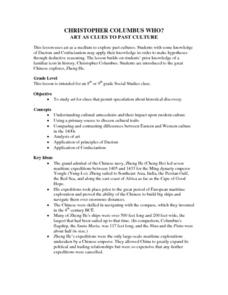Curated OER
Chinese Philosophies & Ethical Codes
Focusing primarily on Confucianism, these slides contrast the philosophies of India with those of China - and introduce the philosophies of Legalism and Daoism as well. Your world history lecture will come alive with the clear outlines...
Curated OER
Chinese Philosophies
Learners compare Confucianism and Daoism. In this Chinese culture lesson, students listen to a lecture comparing the religious philosophies and take a quiz at the end of the lesson.
Curated OER
Early China
Students journey back in time to early China. In this Chinese history lesson, students explore China's geography; read about the Shang, Zhou, and Han Dynasties; compare Confucianism and Daoism. Students create PowerPoint presentations...
Weebly
Ancient China
From China's physical geography and earliest beginnings of civilization to the Qin and Han dynasties, here is a nicely designed worksheet on ancient China, which includes a graphic organizer and timeline to summarize the reading material.
Curated OER
Folktales Reflect Daoist and Buddhist Traditions
Tenth graders compare three Chinese folktales for their "messages" and literary techniques to see how they reflect Chinese Confucian and Taoist values. They discuss how folktales share certain subjects, characters, plots and themes.
Curated OER
Ancient Chinese Philosophies of Government
Sixth graders use the four philosophies of Ancient China to investigate persceptive and resolution of a problem.
Curated OER
The Daoist Immortals
High schoolers discover the basic principles and beliefs of Daoism through investigation and in-class discussion in this High School activity for a Social Studies, Humanities, or Asian Studies class.
Curated OER
The Four Religions of East Asia
Students compare and contrast the four main religions of Asia (Buddhism
Confucianism, Daoism, and Shinto). This lesson plan is intended for use in the middle school Social Studies classroom.
Curated OER
Exploring the Daoist worldview
Students study the accompanying quotes from the Dao dejing, the Zhuangzi and other Daoist writings. They determine particular implications for knowledge issues and ways of knowing.
Curated OER
The Golden Rule of Reciprocity: A Silk Road Encounters Project
Learners are introduced to the Golden Rule of Reciprocity. Using the four major world religions, they compare and contrast quotes about the Golden Rule. In groups, they create their own version of the Rule and share it with the class.
Curated OER
Comparative religious Teachings
Ninth graders examine the goods and culture that was traded along the Silk Road. In this World History lesson, 9th graders compare and contrast the belief systems of the Silk Roads. Students analyze a primary text of sacred and...
Curated OER
Belief Systems of the Silk Roads
Students review, compare, and contrast belief systems of the Silk Roads. They analyze primary texts of sacred and philosophical writings. Finally, students recognize the rich diversity of belief systems along the Silk Roads.
Curated OER
Christopher Columbus Who?
Students recreate a "60-minutes" interview using cue cards and historical information on the Chinese explorer Zheng He. This lesson is an excellent introduction to World History during the 1400's.
Curated OER
The Golden Rule of Reciprocity
Students explore The Golden Rule of Reciprocity from various religions. In this religious beliefs activity, students examine various religious quotes and summarize the idea of The Golden Rule in a sentence.
Curated OER
"For The Birds" [part II]
Students examine how Chinese and Japanese artists used different kinds of birds
as representations of ideas that were important in both cultures and create their own birds using the technique of origami.
Curated OER
"He Says, She Says"
Stuents compare and contrast male and female views of love and beauty in classic Chinese and Japanese society through the reading and evaluation of prose and poetry. Chinese and Japanese art is also studied.
















!["For The Birds" [part II] Lesson Plan "For The Birds" [part II] Lesson Plan](http://content.lessonplanet.com/resources/thumbnails/122476/large/cgrmlwnvbnzlcnqymdeymtaxny0yoda5lwu0ew85zi5qcgc.jpg?1414222640)
